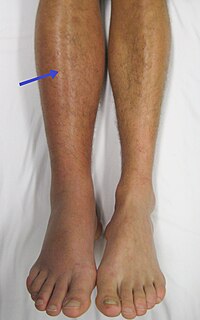
Photo from wikipedia
(1) Background: Hepatic venous occlusion type of Budd–Chiari syndrome (BCS-HV) and pyrrolizidine alkaloid-induced hepatic sinusoidal obstructive syndrome (PA-HSOS), share similar clinical features, and imaging findings, leading to misdiagnoses; (2) Methods:… Click to show full abstract
(1) Background: Hepatic venous occlusion type of Budd–Chiari syndrome (BCS-HV) and pyrrolizidine alkaloid-induced hepatic sinusoidal obstructive syndrome (PA-HSOS), share similar clinical features, and imaging findings, leading to misdiagnoses; (2) Methods: We retrospectively analyzed 139 patients with BCS-HV and 257 with PA-HSOS admitted to six university-affiliated hospitals. We contrasted the two groups by clinical manifestations, laboratory tests, and imaging features for the most valuable distinguishing indicators.; (3) Results: The mean patient age in BCS-HV is younger than that in PA-HSOS (p < 0.05). In BCS-HV, the prevalence of hepatic vein collateral circulation of hepatic veins, enlarged caudate lobe of the liver, and early liver enhancement nodules were 73.90%, 47.70%, and 8.46%, respectively; none of the PA-HSOS patients exhibited these features (p < 0.05). DUS showed that 86.29% (107/124) of patients with BCS-HV showed occlusion of the hepatic vein, while CT or MRI showed that only 4.55%(5/110) patients had this manifestation (p < 0.001). Collateral circulation of hepatic veins was visible in 70.97% (88/124) of BCS-HV patients on DUS, while only 4.55% (5/110) were visible on CT or MRI (p < 0.001); (4) Conclusions: In addition to an established history of PA-containing plant exposure, local hepatic vein stenosis and the presence of collateral circulation of hepatic veins are the most important differential imaging features of these two diseases. However, these important imaging features may be missed by enhanced CT or MRI, leading to an incorrect diagnosis.
Journal Title: Journal of Personalized Medicine
Year Published: 2023
Link to full text (if available)
Share on Social Media: Sign Up to like & get
recommendations!